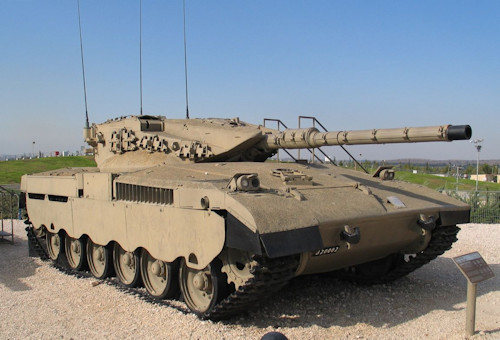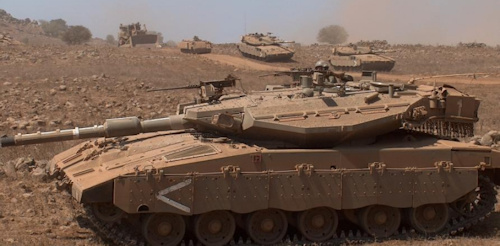A few days ago Difesa Online published yet another article concerning the ARIETE battle tank. Specifically, some critical issues were highlighted (which may have contributed to the death of Corporal Bisconti, in the 2006, during an exercise) of the vehicle which, for economic reasons, will not be resolved with the planned - and currently funded with 35 million - upgrade program.
Our magazine has often suggested - in full autonomy - the Defense to evaluate other options, such as the purchase of foreign wagons such as the Leopard 2A6 / 7 and the MERKAVA Mk-IV. Suggestion dictated by the desire to avoid (as much as possible) other tragedies like that of 13 years ago, besides, of course, to be able to dispose of armored units equipped with adequate means for modern operating theaters.
Some readers, commenting on the aforementioned article, pointed out that the Israeli wagon is not at all a very good means (called an "obsolete wagon"), but even more critical than ARIES.
Convinced of our work of independent information, we feel obliged to provide some clarifications on the MERKAVA and thus refute the criticisms expressed.
The 6 October 1973, at the beginning of the Yom Kippur War, the Israeli Army could deploy over 500 MBT M-48A3 and M-60A1. Once the conflict ended, some remained operative around 200, the others had been destroyed by Egyptian anti-tank missiles (supplied by the Soviets) AT-3 SAGGER.
 The Israeli Armored Corps had suffered heavy losses in both vehicles and men. However, as early as the 70 years, Israeli engineers and engineers had begun developing a new MBT. the MERKAVA (chariot).
The Israeli Armored Corps had suffered heavy losses in both vehicles and men. However, as early as the 70 years, Israeli engineers and engineers had begun developing a new MBT. the MERKAVA (chariot).
A revolutionary vehicle (entered into service in the 1979), designed with the utmost attention to the protection of the crew, as evidenced by the positioning of the engine.
In fact, unlike the other MBTs, the MERKAVA had a front engine, an element that contributed to increasing the protection of the vehicle (coated in composite material) on the front arch (in this way the rear part of the hull could accommodate 4 fucilieri).
The first operational job is in Lebanon in the 1982 (Peace in Galilee operation) where he demonstrated his qualities, outclassing the Syrian T-72.
The first modernized version appeared the following year, the MERKAVA Mk-II was distinguished by its original model for the reinforced armor of the turret, the reinforced side cover skirts, the installation of the Teledyne Continental V12 engine AVDS-1790-A7 from 950 HP, the update of the Matador shooting system and the configuration of the Soltam mortar from 60 m, moved from the outside to the inside of the turret and equipped with a remote controlled shooting system.
The most recent versions of the Mk-II have been designated: Mk-IIB, with IR optics; Mk-IIC, with reinforced armor on the top of the turret to improve protection against attacks from above.
The peculiarity of the project, in our opinion, lies in the fact that the MERKAVA was conceived in such a way as to allow modernization and improvements based on the lessons learned from field operations (only this would be enough to dig an abyss with ARIETE design).
 With this in mind, the MERKAVA Mk-III (produced in 1989 specimens between the 780 and the 1990) entered service in December 2010.
With this in mind, the MERKAVA Mk-III (produced in 1989 specimens between the 780 and the 1990) entered service in December 2010.
This is a completely new MBT, much improved in all its aspects, from mobility to firepower and protection.
The Mk-III has a slightly elongated hull, to house a new V12 Teledyne Continental AVDS-1790-9AR turbodiesel engine from 1.200 HP. The main armament consists of a new MG-251 cannon from 120 mm which, like the one from 105 mm M-68, can fire Israeli LAHAT (Laser Homing Attack) missiles charged to HEAT in tandem. A new and sophisticated shooting control system has been associated with the new piece, with laser designators, while the wagon protection has been completely revised with the adoption of a modular composite protection, which allows a continuous technological updating as well as, in the the possibility of damage, rapid replacement.
In the 1995 (ARIETE is still far from entering service) the first update of the Mk-III takes place, with the BAZ package (hawk), which includes the installation of the ATT (Automatic Target Tracker) for the shooting conduct system, thus allowing the wagon to fire while moving against pure targets them in motion. The ballistic protection is further increased through the adoption of a new modular additional shell called Kasag, made of composite steel-ceramic material. Furthermore, a centralized air conditioning and NBC protection system was adopted and an independent IR periscope for the wagon.
 In the 2004 the MERKAVA Mk-IV enters into service, which stands out from the previous versions due to the newly designed turret and hull.
In the 2004 the MERKAVA Mk-IV enters into service, which stands out from the previous versions due to the newly designed turret and hull.
The turret does not include the server door (which can take the blows from a warehouse consisting of two rotating drums arranged in the rear baffle. The semi-automatic loading system, which contains 10 ready-to-use shots of four different types, selectable automatically, it is electrically operated and the choice of ready-to-use shots is controlled by a microprocessor) so as to improve its protection from attacks from above. The main armament is always constituted by the 120 mm smooth-bore cannon but in the MG-253 version, able to withstand greater pressures than the MG-251.
As for loading instead, when the wagon moves on varied terrain, it can negatively affect the safety of the crew. As in most battle floats, the firearm is stabilized both in elevation and in tilt during movement, but the barrel changes its elevation angle in relation to the tilt level of the turret.
To avoid this, a new system has been installed that blocks the barrel at a particular angle during the loading process to facilitate the shot introduction sequence; subsequently the barrel resumes its previous stabilized position, once the loading is completed.
The Mk-IV is equipped with an advanced integrated shooting control system that uses ballistic calculations, performed by a sophisticated on-board computer whose software is programmed to take into account all the parameters that could influence the ballistic equation.
 The ATS (Automatic Tracking System) tracking system of the second generation hooks the target at a distance of a few km, chasing it automatically whether it is a moving vehicle on the ground, whether it is a low-flying helicopter.
The ATS (Automatic Tracking System) tracking system of the second generation hooks the target at a distance of a few km, chasing it automatically whether it is a moving vehicle on the ground, whether it is a low-flying helicopter.
The gunner's sight then begins the fire sequence, regardless of any evasive action the target may attempt.
The moving fire is made possible by an ultra-fast turret stabilization electrical system, which allows the target to be locked to the target even if the wagon is moving on rough terrain.
The latest version appeared is the Mk-IVM equipped with the TROPHY active protection system - known as ASPRO-A in the name of the Tsahal or more familiarly MEIL RUACH (wind jacket) - by Rafael / Elta. The first Brigade with the new version became operational in the 2011. The TROPHY system successfully intercepted rockets and anti-tank missiles, including the AT-14 SPRIGGAN, fired by Hamas militiamen in Gaza, during the 2014 Protection Margin operation.
At the end of our discussion on MERKAVA we can say that this is certainly not an obsolete MBT. Since its entry into service it has undergone constant updating, the result of the experience gained by the Israeli Armored Corps in the countless real operations.
The presence of the propeller in the front position constitutes an element of further protection, a solution adopted, inter alia, on CENTAURO I and II.
Obviously the indestructible chariot does not exist

During the Second Lebanon War of the 2006, the Israeli Armored Corps lost in battle 52 of the 400 Mk-II, III and IV used in combat (although most were badly damaged, more than destroyed). Losses caused mainly by tactical errors and lack of adequate training by the crews.
In fact, as the last operations have amply demonstrated, the doctrine has changed, modeling itself on a concept of total asymmetric warfare, where the chariot, which first fired and observed from great distances, increasingly finds itself facing small teams at short distances equipped with the latest anti-tank weapons.
Therefore, the new operational scenarios impose not only adequate means but also tactics that allow us to suffer as little damage as possible.
The ARIETE was designed in the middle of the Cold War, as it was thought that the Soviet armored divisions at the Threshold of Gorizia were faced. The end of the Soviet bloc led to a sharp decline in defense spending, delaying the entry into service of the ARIETE of over 10 years. In the 2002 a specimen of the wagon with the additional protection kit was presented at the Eurosatory in Paris (it was mistakenly thought of an updated version called C-2), in reality it was only a mock-up.
The update program that will affect ARIETE will not make it able to deal with future theaters of operation, however the Defense will invest huge funds that could instead be used to acquire more modern MBTs.
On the other hand, what emerges without distinction from the design history of the MERKAVA is a country system that invests in armaments with the aim of guaranteeing the survival of the Jewish State and its position in the international context.
Photo: IDF / web












